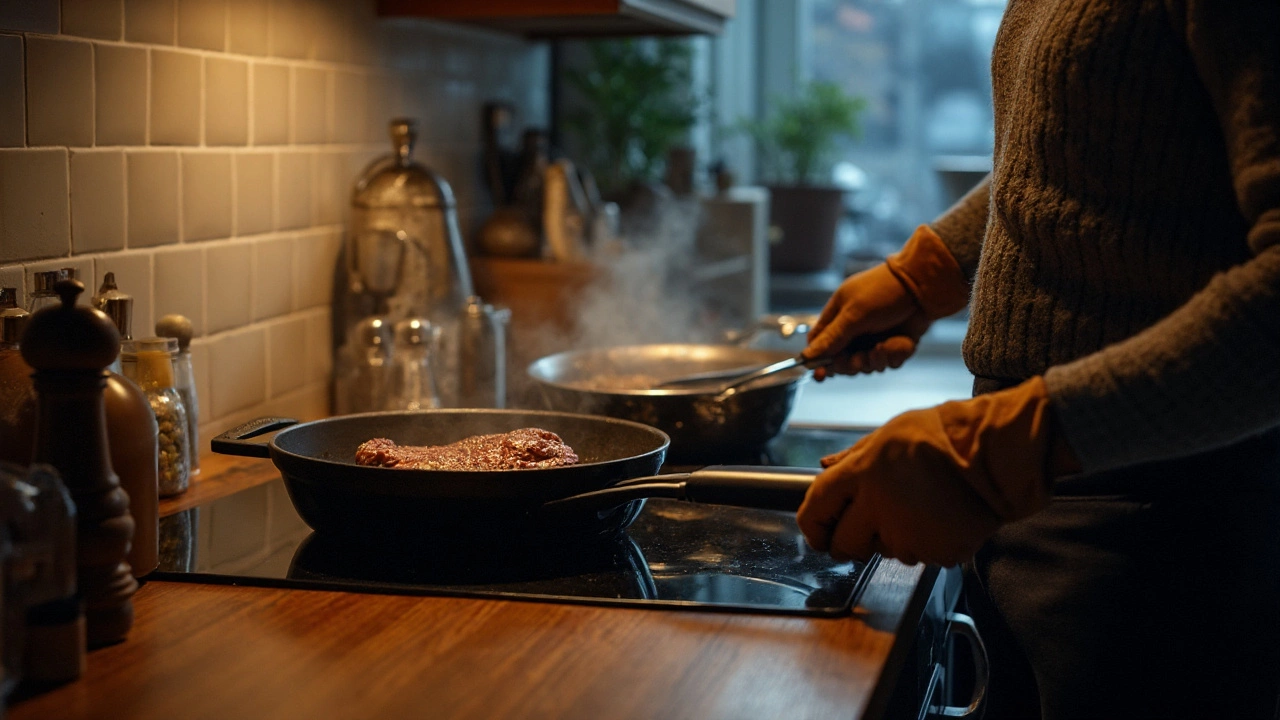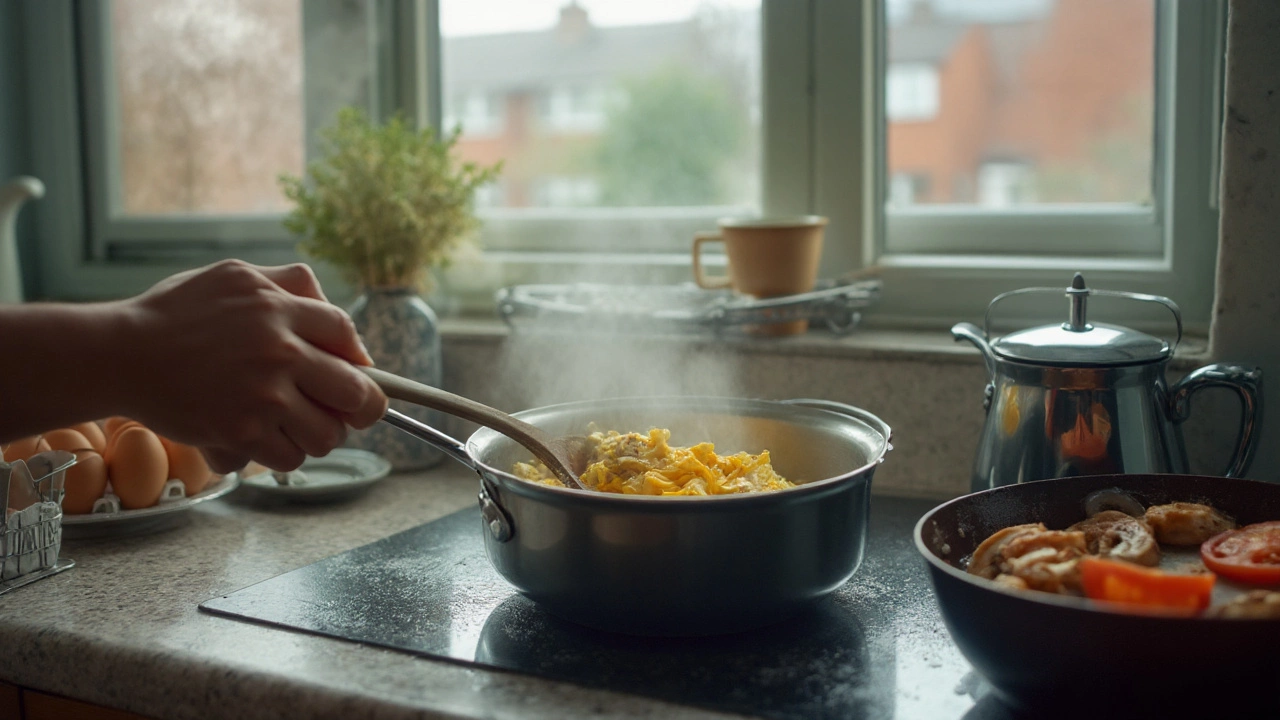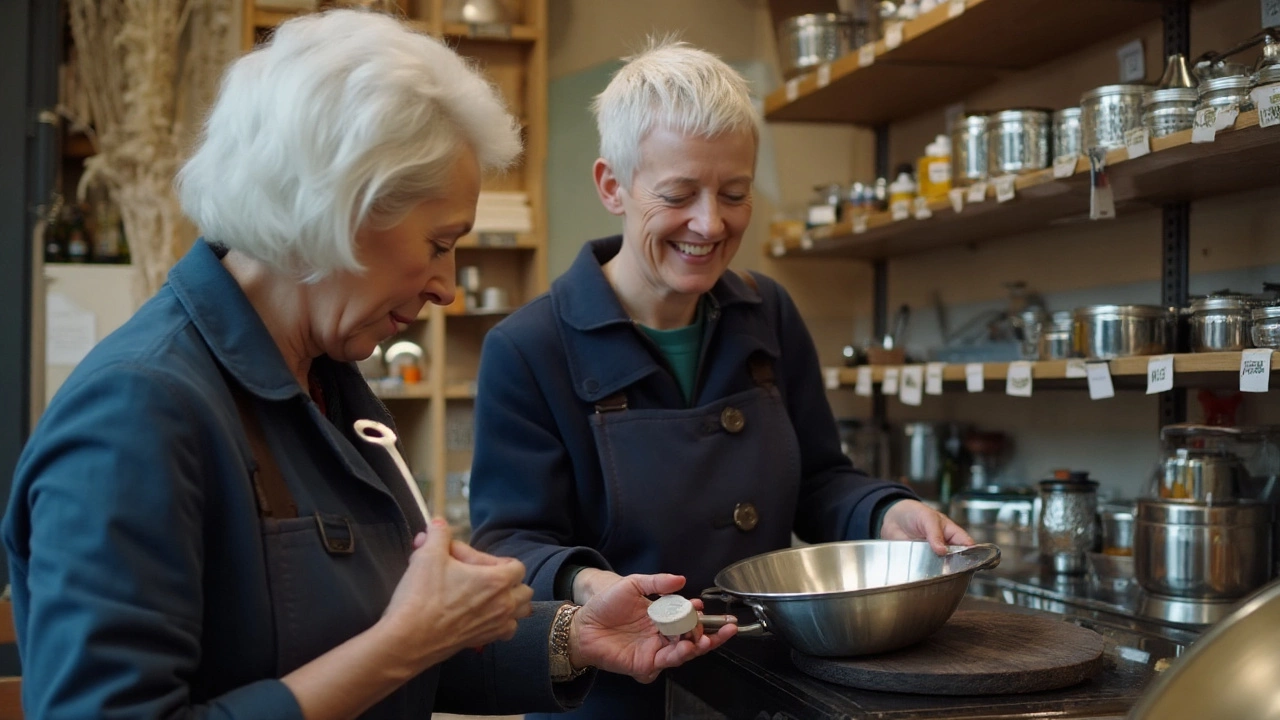Cast Iron vs Stainless Steel: Which Cookware Is Better and When to Use Each

You’re not choosing a team. You’re choosing the right tool for how you actually cook. If you want steakhouse sear, weekend shakshuka, and easy weeknight sauces out of the same pan, one material will frustrate you. The other will sing. Here’s the honest answer: neither is “better” in every situation-but one will be better for you today, in your kitchen, on your stove. I’ll show you exactly when to reach for cast iron and when stainless wins.
TL;DR: The short answer and a fast decision tree
If you came for the quick verdict, here it is. For rock-solid browning and heat that doesn’t tank when cold food hits the pan, pick cast iron. For responsive heat, silky pan sauces, and less heavy lifting, pick stainless steel. The smartest home cooks in Wellington (and anywhere) often use both.
- Steak, burgers, cornbread, pommes Anna, deep-frying: cast iron.
- Stir-fries on induction, tomato sauces, quick sautés, delicate fish: stainless steel.
- Eggs: well-seasoned cast iron or nonstick; stainless works if you master preheat and fat.
- Acidic dishes (tomato, wine, citrus): stainless-unless you’re okay with extra iron notes.
- Hate heavy pans or have a glass cooktop? Stainless will feel nicer day to day.
Fast decision tree:
- Need maximum sear or deep-fry stability? → Cast iron.
- Making a sauce that needs a clean, bright flavor? → Stainless.
- Cooking acidic foods for 10+ minutes? → Stainless.
- Want fewer sticking headaches and you’re okay with a learning curve? → Either; preheat properly.
- Have induction and want instant control? → Stainless (fully clad). Cast iron works, just slower to react.
Put simply: choose cast iron vs stainless steel based on the dish, not brand hype.
What to weigh before you choose (the decision criteria that matter)
Before you buy-or before you reach for a pan-check these six criteria. They decide how your food will cook more than any “best cookware” list.
- Heat retention vs responsiveness: Cast iron is a thermal battery. It runs slow to heat, slow to cool, and shrugs off temperature drops when you add cold food. Stainless (especially fully clad with an aluminum core) heats fast and responds quickly when you tweak the dial-perfect for sautés and pan sauces.
- Sticking and release: A well-seasoned cast iron gets near-nonstick for many foods. Stainless can be nearly nonstick if you preheat until the oil shimmers, then add dry, room-temp proteins. Protein sticks when the pan is too cool or the food is wet-that’s user error, not a flaw in the metal.
- Acid and reactivity: Tomatoes, wine, vinegar, and citrus can dissolve a bit of iron from cast iron and dull seasoning. Stainless steel is stable with acid and keeps flavors clean. If you simmer long with acid, stainless wins.
- Weight and ergonomics: Cast iron is heavy-great on a windy Wellington night when you want heat that lasts, not so great if you’ve got a glass cooktop or a sore wrist. Stainless is lighter, easier to toss veg, and kinder on glass.
- Maintenance: Cast iron likes a quick dry and a wipe of oil; it rewards care with better release over time. Stainless is dishwasher-safe (check your maker’s guidance) but hand-washing preserves the shine. Burnt-on bits? A baking-soda paste or Bar Keepers Friend sorts it in minutes.
- Health and safety: Cast iron can add dietary iron to food-good for many, not ideal if you’re on a medically supervised low-iron regimen. Stainless may leach tiny amounts of nickel/chromium with acidic cooking, especially when new. Both are considered safe for general use by food-safety authorities like FSANZ.
Here in New Zealand, lots of homes run induction or ceramic. Both materials work on induction, but not every stainless pan is magnetic. Bring a fridge magnet to the shop-if it sticks, you’re sweet.

Side-by-side comparison (with numbers you can use)
Specs aren’t everything, but they explain why your steak crusts beautifully in one pan and steams in another.
| Feature | Cast Iron (10-12 inch skillet) | Stainless Steel (3-ply/5-ply, 10-12 inch) |
|---|---|---|
| Thermal behavior | High heat retention, slower to heat/cool | Fast to heat, fast to adjust |
| Typical weight | 2.5-3.5 kg | 1.0-1.6 kg |
| Heat tolerance | Up to 260-300°C (500-570°F) easily; higher bare | Often 260-315°C (500-600°F); check handles/finish |
| Induction compatibility | Yes | Yes if magnetic (most clad sets are) |
| Reactivity with acid | Reactive; seasoning can dull with long acidic cooks | Non-reactive; ideal for tomato/wine sauces |
| Sticking risk | Low when well-seasoned and preheated | Low with proper preheat and fat; higher if rushed |
| Cleaning | Hand-wash, dry hot, light oil; avoid soaking | Hand or dishwasher (brand-dependent) |
| Price (NZD, typical) | $60-$180 for a skillet | $120-$350 per pan (clad) |
| Longevity | Decades; seasoning improves with use | Decades; finish stays stable if cared for |
On leaching and safety, two pieces of evidence worth knowing:
“Stainless Steel Leaches Nickel and Chromium into Foods During Cooking.” - Journal of Agricultural and Food Chemistry (Kamerud KL, Anderson KA, 2013)
And from nutrition research: randomized trials in Ethiopia found families using iron pots saw improved iron status in children (Adish et al., The Lancet, 1999). That doesn’t mean everything should be cooked in cast iron-just that the effect is real.
Best for / Not for, with real-world scenarios
Here’s where the rubber meets the hob. What are you cooking tonight?
- Thick steak or smash burgers: Cast iron wins. Preheat 5-8 minutes, medium-high, until a drop of water dances. Sear with a high-smoke-point oil. The mass keeps the surface hot after cold beef hits it, so you get crust-not gray patchwork.
- Pan sauces (wine reduction, peppercorn): Stainless wins. You’ll build fond quickly, then deglaze into a silky sauce without iron flavor notes. It’s easier to stop the reduction at the exact nappe point because heat responds fast.
- Eggs and delicate fish: Two routes. Well-seasoned cast iron works great for eggs if you preheat gently and use enough fat. For fish with fragile skin (tarakihi, snapper), stainless is excellent when you master the preheat-and-dry routine. If you’re not in the mood to think, grab nonstick.
- Tomato shakshuka or long-simmered bolognese: Stainless. It handles acid gracefully. Cast iron is fine for quick tomato work, but long acidic simmering can strip seasoning and add metallic hints.
- Stir-fries on induction: Stainless (clad) or carbon steel wok. Cast iron can work, but it isn’t as nimble for fast heat moves.
- Cornbread, cobbler, roasts: Cast iron. Oven-to-table heat retention keeps food warm through a long dinner.
- Deep-frying: Cast iron for heat stability; stainless stockpot or Dutch oven also fine. Use a thermometer and don’t overcrowd.
Best for / Not for, at a glance:
- Cast iron - Best for: hard searing, frying, baking, any time you want stable heat and a dark crust. Not for: long acidic cooks, super light tossing, or anyone who dislikes heavy pans.
- Stainless - Best for: quick sautés, pan sauces, acidic dishes, responsive control. Not for: repeated high-heat sear on underpowered hobs where thermal mass matters.
Trade-offs you’ll actually feel on a weeknight:
- Power vs finesse: Cast iron brings power and steadiness; stainless brings finesse and speed.
- Cleanup style: Cast iron is a 90-second ritual-hot rinse, wipe, oil. Stainless is either a slick scrub or a dishwasher drop (brand guidance allowing).
- Learning curve: Both reward a proper preheat. Stainless is less forgiving if you rush or crowd the pan; cast iron is less forgiving if you cook acidic for long.
If your cooktop runs cool (some rentals around Wellington do), cast iron helps hold heat; if your induction is punchy, stainless shines because you can dial heat up or down with surgeon-level control.

Care, safety, and smart buying (plus a few savvy alternatives)
Care tips:
- Seasoning cast iron: Start with a light film of neutral oil (grapeseed, canola). Bake upside down at 220-240°C for 1 hour. Repeat 2-3 times for a robust base. Regular cooking with a little fat will keep improving it.
- Daily clean, cast iron: While warm, wipe out. Stuck bits? Add a splash of water, simmer 30 seconds, scrape with a wooden spatula, dry over heat, then oil lightly.
- Daily clean, stainless: Deglaze while it’s still warm-water, stock, or wine. Stains? A paste of baking soda or a sprinkle of Bar Keepers Friend and a soft scrub pad. Rinse well.
- Handles and lids: For oven use, check handles. Many stainless pans have metal handles rated to 260-315°C; silicone-wrapped handles may cap at lower temps.
- Salt timing: Don’t throw salt into a dry stainless pan (pitting risk). Add after liquid. With cast iron, salt is fine anytime.
Safety and health notes:
- Iron intake: Cast iron can raise iron content in food, especially with acid. That’s beneficial if you’re low on iron (common here, especially among endurance athletes). If you have hemochromatosis or high ferritin, ask your clinician before relying on cast iron daily.
- Nickel sensitivity: Some stainless alloys contain nickel. The 2013 J Agric Food Chem study found nickel and chromium leach more with acidic foods and longer cooking times, especially from new pans. If you’re nickel-sensitive, consider low-nickel stainless (e.g., 18/0) or use cast iron or enamel-lined steel for acidic dishes.
- Food safety authorities: FSANZ and peer agencies regard both materials as food-safe when used as intended. Don’t store leftovers in cast iron, and avoid harsh chlorine cleaners on stainless.
Buying tips (save money, get performance):
- Cast iron: A basic 26-30 cm skillet covers 90% of tasks. Brands matter less than mass and flatness; a flat base is crucial on induction/glass. Second-hand is great-rust is fixable.
- Stainless: Look for fully clad (aluminum or copper sandwiched through the sides, not just a disc on the bottom). Try the magnet test. Weight should feel balanced-too light often means hot spots.
- Handles: You’ll live with these for decades. Go for riveted or solid-weld handles that feel secure in a wet hand.
- Size: Don’t crowd. A 30 cm skillet fits two large steaks or four chicken thighs without steaming.
Smart alternatives (and when they beat both):
- Carbon steel: Like a lighter cast iron with faster response. Brilliant for eggs and searing once seasoned.
- Enameled cast iron: Non-reactive interior with cast iron heft. Ideal for acidic slow braises. Not as nonstick as seasoned bare iron.
- Nonstick: For eggs and delicate fish when you want zero drama. Keep it at medium heat, use silicone/wood tools, and replace every few years.
FAQ (quick hits):
- Do I need to season stainless? No. Just clean well and preheat before adding oil.
- Why does my stainless stick? Pan was too cool, food was wet, or you moved it too soon. Preheat until oil shimmers, pat food dry, let proteins release before flipping.
- Can I use soap on cast iron? Yes. Modern soaps don’t strip seasoning if you dry and re-oil. Avoid soaking.
- Is black residue from cast iron safe? Usually yes-polymerized oil/carbon. If it flakes, you’re due for a light scrub and reseason.
- Glass cooktop safe? Both can work. Be gentle with cast iron to avoid scratches; lift, don’t slide.
Next steps for different cooks:
- Busy weeknight cook: Get one 30 cm stainless skillet for sautés and sauces plus a small nonstick for eggs. Add cast iron later.
- Steak-first cook: Start with a 30 cm cast iron. Pair with a 2-3 L stainless saucier for pan sauces.
- Induction household: Choose fully clad stainless for responsiveness; keep a cast-iron skillet for sear nights.
- Budget build: Buy a used cast iron for under $50 NZD and a single good stainless skillet. Skip full sets until you know what you actually use.
If you do one thing differently tonight, preheat properly. With cast iron, give it time. With stainless, wait for the first wisp of shimmer in the oil. That single habit closes 80% of the sticking and searing gap-and makes whichever pan you own feel like the right one.